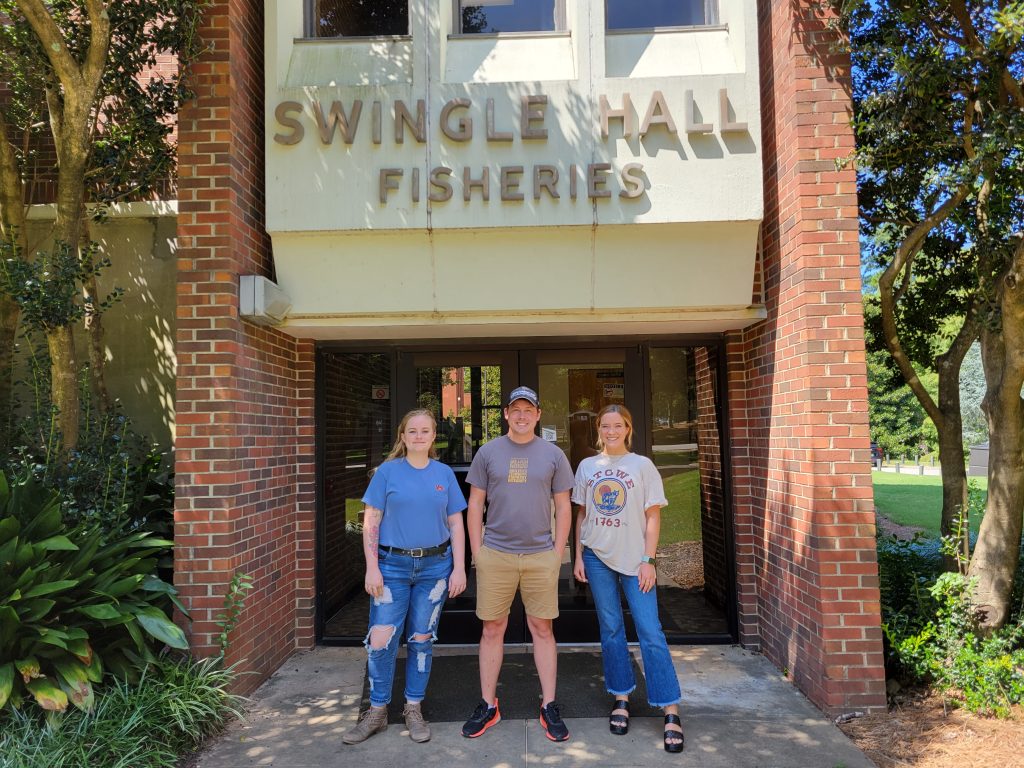Dr. Nathan Whelan joined the Department of Biological Sciences in 2008 after finishing his B.S. at Truman State University. Dr. Whelan worked in Dr. Phil Harris’s lab on a dissertation entitled “Conservation, life history and systematics of Leptoxis Rafinesque 1819 (Gastropoda: Cerithioidea: Pleuroceridae).” Subsequently he moved just down the road to conduct postdoctoral research with Dr. Ken Halanych at Auburn University, and he is currently Director of the US Fish and Wildlife Service Southeast Conservation Genetics Lab and an Assistant Research Professor in the School of Fisheries, Aquaculture and Aquatic Sciences at Auburn University. We caught up with Dr. Whelan to ask about his time in the Department and his career since he graduated.
Why did you decide to do your Ph.D. at UA?
When I finished my undergraduate degree at a small liberal arts college (Truman State University), I was looking for the chance to continue my education at a larger research institution. I visited Tuscaloosa in the fall of my Senior year, and I really enjoyed the people I met and the UA campus. At the time, I was very interested in systematics, evolutionary biology, and aquatic conservation. Given the systematics research being done at UA and the aquatic diversity in the southeast, UA seemed like the perfect place for me to get a Ph.D.
Do you have a funny story related to your time at UA you can share?
One thing I learned at UA that I think has served me well during my career is to question “common knowledge” of your respective field. In spring 2011, I was visiting the University of Florida Natural History Museum with Paul Johnson (Alabama Department of Conservation and Natural Resources or ADCNR). We stayed with Jim Williams, a UA alum who wrote the Alabama and Florida mussel books. One night after working in the museum, we were at Jim’s house discussing future research plans, and I told him I thought it would be worth it to organize a float trip on the Cahaba River to look for the “extinct” Oblong Rocksnail. As I was telling Jim that I has spent some time looking at the museum collections of Oblong Rocksnails to determine where it was most abundant historically, Paul was behind me shaking his head at Jim as if I was crazy because the species was certainly extinct. When I noticed this, in a bit of youthful stubbornness, I knew I had to prove him wrong!
A few weeks later, on a Sunday in May, I wrangled a couple friends to go on a 10 km canoe trip looking for the Oblong Rocksnail. I found it within the first 0.5 km. I brought about 30 Oblong Rocksnails back to Paul’s facility in Marion, Alabama that night. The next morning, when I arrived at the Alabama Aquatic Biodiversity Center (AABC), I went in the back, grabbed a couple snails, and put them in a petri dish. Paul was on the phone, but I walked into his office, put the petri dish on his desk the snails down, and went to another building at AABC to work on another one of my dissertation chapters. I don’t think Paul believed my species ID at first, but by the end of the day I had him convinced. I owe Paul though. He has always been supportive of my research ideas, and I may not have been stubborn enough for a 10 km canoe trip if he hadn’t been given me a good-natured hard time that I was misguided to think that the Oblong Rocksnail was still out there.
What was your favorite part of your Ph.D. experience?
There were so many aspects of my time at UA that I loved. Picking a single experience would be impossible. I made life-long friends while doing research that I’m very proud of that advanced the field. Trips to collect snails in Tennessee and Alabama with colleagues from the Alabama Department of Conservation and Natural Resources that I still collaborate with were high points of my research experiences. I also really enjoyed organizing tailgates and watching the Tide win three football national championships.
Are you still involved in any collaborations you initiated here in the department?
One of the great aspects of my time at UA was the collaborations I developed as part of my PhD research. I still collaborate with Jeff Garner and Paul Johnson from the ADCNR. I also still collaborate with Ellen Strong, Chair of Invertebrate Zoology, Research Zoologist and Curator of Mollusks at the Smithsonian National Museum of Natural History. We all recently published a phylogenomic study on Pleuroceridae (https://doi.org/10.18061/bssb.v1i2.8419), which builds considerably on my dissertation work.
Since completing his Ph.D., Dr. Whelan has been a highly successful researcher and mentor to the next generation of biologists. He and his team are investigating evolutionary relationships within diverse groups of organisms, processes that generate biodiversity, and how environmental changes influence genetic patterns. His research program has direct implications on conservation efforts in animals ranging from endangered molluscs to fish, but he is also a leader in the field of phylogenetics where his expertise in theory and expertise in computational tools have helped the field understand which models and methods can provide the most accurate inference of evolutionary relationships. At the time of writing this article, he has published 42 peer-reviewed journal articles including several in top journals such as Proceedings of the National Academy of Sciences, Nature Ecology and Evolution, Nature Communications, and Molecular Ecology (just to name a few) and he has been awarded over $4M in research grants and fellowships since 2008.

